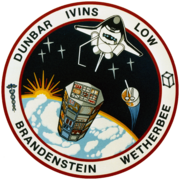
Back STS-32 Arabic STS-32 Bulgarian STS-32 Czech STS-32 Danish STS-32 German استیاس-۳۲ Persian STS-32 French STS-32 Galician STS-32 HE STS–32 Hungarian
 Columbia retrieves the Long Duration Exposure Facility. | |
| Names | Space Transportation System-32 STS-32R |
|---|---|
| Mission type | Syncom IV-F5 satellite deployment LDEF satellite retrieval |
| Operator | NASA |
| COSPAR ID | 1990-002A |
| SATCAT no. | 20409 |
| Mission duration | 10 days, 21 hours, 36 seconds |
| Distance travelled | 7,258,096 km (4,509,972 mi) |
| Orbits completed | 172 |
| Spacecraft properties | |
| Spacecraft | Space Shuttle Columbia |
| Launch mass | 116,117 kg (255,994 lb) |
| Landing mass | 103,571 kg (228,335 lb) |
| Payload mass | 12,014 kg (26,486 lb) |
| Crew | |
| Crew size | 5 |
| Members | |
| Start of mission | |
| Launch date | January 9, 1990, 12:35:00 UTC (7:35 am EST) |
| Launch site | Kennedy, LC-39A |
| Contractor | Rockwell International |
| End of mission | |
| Landing date | January 20, 1990, 09:35:36 UTC (1:35:36 am PST) |
| Landing site | Edwards, Runway 22 |
| Orbital parameters | |
| Reference system | Geocentric orbit |
| Regime | Low Earth orbit |
| Perigee altitude | 296 km (184 mi) |
| Apogee altitude | 361 km (224 mi) |
| Inclination | 28.45° |
| Period | 91.10 minutes |
| Instruments | |
| |
 STS-32 mission patch  Standing: Ivins, Low and Dunbar Seated: Brandenstein and Wetherbee | |
STS-32 was the 33rd mission of NASA's Space Shuttle program, and the ninth launch of Space Shuttle Columbia. Launched on January 9, 1990, it marked the first use of the Launch Complex 39A of Kennedy Space Center since 1986; it also marked the first use of Mobile Launcher Platform-3 (MLP-3) in the Space Shuttle program. STS-32 was, at the time, the longest shuttle mission yet conducted, with a duration of nearly 11 days. Before STS-32, the only mission of the same duration had been STS-9 in 1983. On January 20, 1990, STS-32 executed the third night landing of the shuttle program. STS-32 was also the first Shuttle mission of the 1990s.
The mission was technically designated STS-32R, as the original STS-32 designator had been used internally for STS-61-C, the 24th Space Shuttle mission. Official documentation and flight paperwork for that mission had contained the designator STS-32 throughout. Flights with the STS-26 through STS-33 designators used the R in their documentation to avoid conflicts in tracking data from one mission to another.[1]
- ^ Jenkins, Dennis (2013). Space Shuttle: Developing an Icon 1972-2013 (1st ed.). Volume III: Specialty Press. p. 144. ISBN 9781580072496.